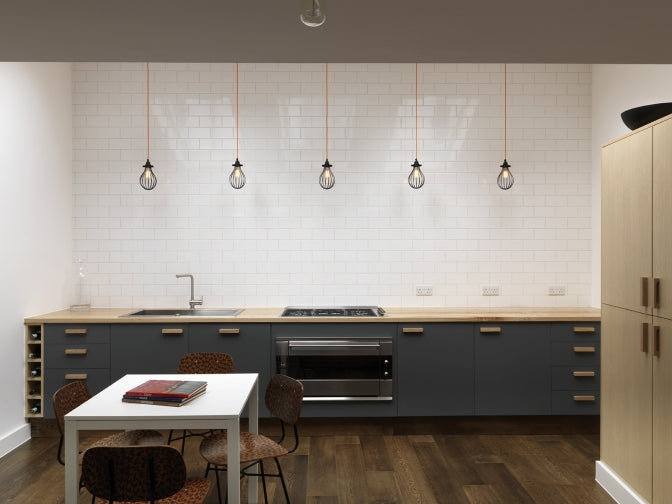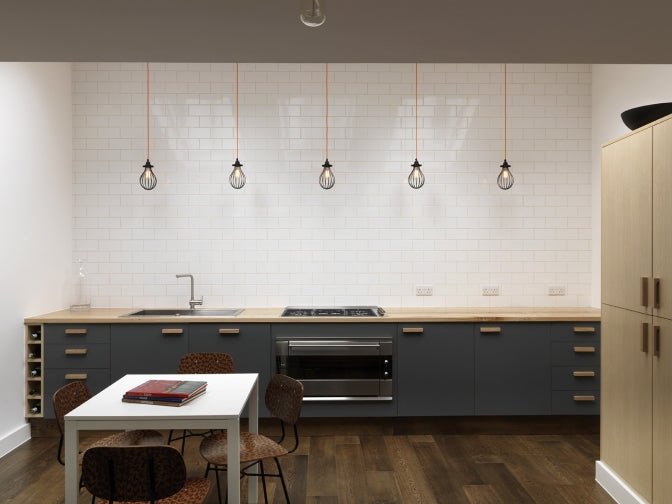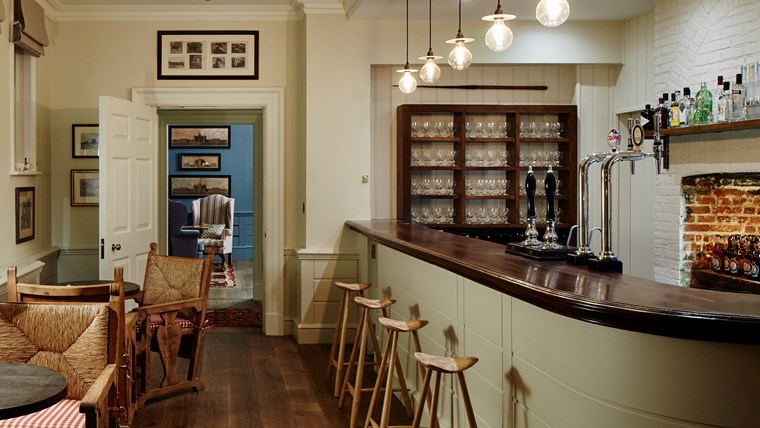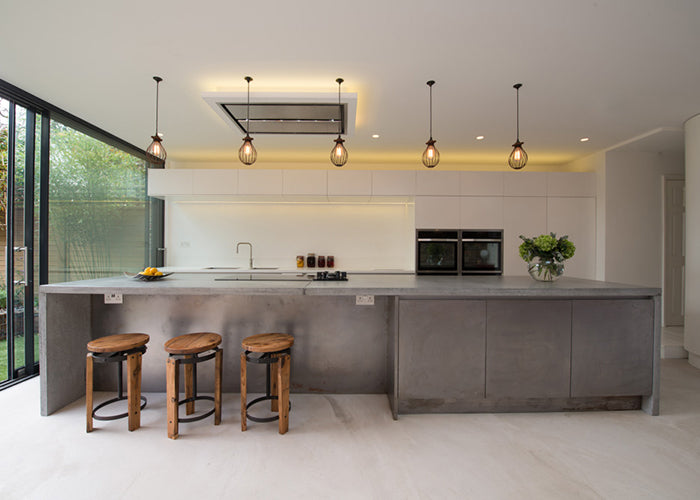For commercial projects, the technical knowledge and aesthetic judgement of a lighting design professional may be required to ensure a lighting scheme meets the aims of the project. But: for projects in the home, there are several concepts which can help 'amateur' lighting designers create effective lighting. Part 5 of Lighting 101 - Basics of Lighting Design - focusses on these concepts.
 Lighting in a bedroom: the general lighting is provided by natural light or a small central ceiling pendant. The bedside light provides task lighting for reading in bed.
Different rooms have different purposes and therefore require different light levels. The level of illuminance on a surface is measured in lux (or lumens per m² - see Unit 1 - The Nature of Light for information about the measurable characteristics of light). A kitchen may require 300 lux and a bedroom only 150 lux. General lighting needs to be distributed effectively through the room with no areas of complete shadow or darkness. Natural light in a room comes - obviously - through glazing and there are a huge range of light fittings or luminaires - including recessed lighting, pendant lights and wall lights - which can provide artificial general lighting.
Lighting in a bedroom: the general lighting is provided by natural light or a small central ceiling pendant. The bedside light provides task lighting for reading in bed.
Different rooms have different purposes and therefore require different light levels. The level of illuminance on a surface is measured in lux (or lumens per m² - see Unit 1 - The Nature of Light for information about the measurable characteristics of light). A kitchen may require 300 lux and a bedroom only 150 lux. General lighting needs to be distributed effectively through the room with no areas of complete shadow or darkness. Natural light in a room comes - obviously - through glazing and there are a huge range of light fittings or luminaires - including recessed lighting, pendant lights and wall lights - which can provide artificial general lighting.
 Lighting over a work surface: caged pendant lights are used to provide task lighting and also for effect lighting - the cages are themselves striking and enhance the industrial aesthetic of the kitchen design.
Also crucial with task lighting are issues of shadow and glare. Although the human eye can cope with a huge range of light levels, highly contrasting levels cause problems. Glare is caused when the light source is too bright and/or directly in view. Even low levels of glare cause the pupils to contract which can defeat the point of task lighting. Higher levels of glare cause unwanted visual effects - spots or blotches in the vision - caused by photo-bleaching in the retina. Shadow is caused by an obstruction between the light source and the thing being viewed - either the viewer or some other object. Consideration needs to be given to glare and shadow when planning the positioning of and type of light fittings for task lighting.
Lighting over a work surface: caged pendant lights are used to provide task lighting and also for effect lighting - the cages are themselves striking and enhance the industrial aesthetic of the kitchen design.
Also crucial with task lighting are issues of shadow and glare. Although the human eye can cope with a huge range of light levels, highly contrasting levels cause problems. Glare is caused when the light source is too bright and/or directly in view. Even low levels of glare cause the pupils to contract which can defeat the point of task lighting. Higher levels of glare cause unwanted visual effects - spots or blotches in the vision - caused by photo-bleaching in the retina. Shadow is caused by an obstruction between the light source and the thing being viewed - either the viewer or some other object. Consideration needs to be given to glare and shadow when planning the positioning of and type of light fittings for task lighting.
 Task lighting in front of a bathroom mirror: the light fittings are positioned close to and directed so as to illuminate the face while not being directly in the line of sight to prevent glare.
Task lighting in front of a bathroom mirror: the light fittings are positioned close to and directed so as to illuminate the face while not being directly in the line of sight to prevent glare.
 Lighting in an open place space: the under-cabinet lights provide task lighting on the work surface; the central pendant provides general lighting for the space; and the standard lamp with shade provides ambient lighting.
Another consideration is the colour temperature of ambient lighting. It seems humans find warmer colour temperatures - less white and more yellow or orange light - such as those from a fire or the setting sun soothing and relaxing. There are number of options for creating effective ambient lighting. Firstly, choose a light fitting or light source with an appropriate colour temperature - 2,500K is a good starting point - and which can be dimmed to reduce the light output. Secondly, ambient lighting may come from indirect light: where light is reflected from a surface (walls, ceilings and floors) or is passed through a medium. Standard or table lights may cast light on ceilings and floors and shades are available in a huge range of translucent materials - coloured glass, fabric, etc. Wall lights can have similar shades or be designed to provide no direct light but to 'wash' surfaces with light. Reflecting light from a surface or passing it through a shade can reduce the intensity and make the light warmer and softer.
Lighting in an open place space: the under-cabinet lights provide task lighting on the work surface; the central pendant provides general lighting for the space; and the standard lamp with shade provides ambient lighting.
Another consideration is the colour temperature of ambient lighting. It seems humans find warmer colour temperatures - less white and more yellow or orange light - such as those from a fire or the setting sun soothing and relaxing. There are number of options for creating effective ambient lighting. Firstly, choose a light fitting or light source with an appropriate colour temperature - 2,500K is a good starting point - and which can be dimmed to reduce the light output. Secondly, ambient lighting may come from indirect light: where light is reflected from a surface (walls, ceilings and floors) or is passed through a medium. Standard or table lights may cast light on ceilings and floors and shades are available in a huge range of translucent materials - coloured glass, fabric, etc. Wall lights can have similar shades or be designed to provide no direct light but to 'wash' surfaces with light. Reflecting light from a surface or passing it through a shade can reduce the intensity and make the light warmer and softer.
General Light
General lighting is described as light to live by - the light in a room to ensure the general purposes of the room are met. Enough light so that everyday activities can be performed and people can see what they are doing. During the day, the general light may be simply natural light from the sun with artificial light being only required at night. Lighting in a bedroom: the general lighting is provided by natural light or a small central ceiling pendant. The bedside light provides task lighting for reading in bed.
Lighting in a bedroom: the general lighting is provided by natural light or a small central ceiling pendant. The bedside light provides task lighting for reading in bed.Task Lighting
As the name suggest, task lighting is light for a particular task or activity. The huge range of human activities require different types of light. A moderately bright light with a warm colour temperature will be fine for reading in bed, but for applying make-up or grooming in a mirror, then a much brighter light which both approximates to daylight in colour temperature and which renders skin tones and colours accurately will be required. Lighting over a work surface: caged pendant lights are used to provide task lighting and also for effect lighting - the cages are themselves striking and enhance the industrial aesthetic of the kitchen design.
Lighting over a work surface: caged pendant lights are used to provide task lighting and also for effect lighting - the cages are themselves striking and enhance the industrial aesthetic of the kitchen design. Task lighting in front of a bathroom mirror: the light fittings are positioned close to and directed so as to illuminate the face while not being directly in the line of sight to prevent glare.
Task lighting in front of a bathroom mirror: the light fittings are positioned close to and directed so as to illuminate the face while not being directly in the line of sight to prevent glare.Ambient Lighting
The purpose of ambient or mood lighting is to give a room or space warmth and character. Socialising and relaxation are an essential part of life and ambient lighting meets these needs. Socialisation and relaxation are encouraged by low light levels - certainly levels much lower than those required for general or task lighting. Similarly, areas of shadow and darkness may actually improve the ambience rather than create problems. Lighting in an open place space: the under-cabinet lights provide task lighting on the work surface; the central pendant provides general lighting for the space; and the standard lamp with shade provides ambient lighting.
Lighting in an open place space: the under-cabinet lights provide task lighting on the work surface; the central pendant provides general lighting for the space; and the standard lamp with shade provides ambient lighting.Effect Lighting
Effect lighting is lighting which is designed to provide visual interest - either the lighting fitting itself or the light produced. In practice, every light fitting has a 'decorative' aspect. Even a light fitting to a starkly simple design and which has no ornamentation or colour makes a contribution to a minimalist room or space. At the other end of the spectrum, a large crystal glass chandelier is striking to look at and can create pattern of brightness or colour on wall and ceilings. Perhaps the key to effect lighting is to ensure that the light fittings in the room work with the interior design - whether that be to fit into the overall design themes of the room or space or to contrast with them in a way which is stylish or attractive. And as with all interior design - it is important not to have too many features or elements and the room will look cluttered or messy. Unlike the other forms of lighting, effect lighting obviously raises directly issue of taste, fashion and style which are more difficult to resolve.
Dining table lighting: the light fittings provided sufficient light for dining while being aesthetically impressive - the lighting is itself a feature of the room.




Leave a comment
This site is protected by reCAPTCHA and the Google Privacy Policy and Terms of Service apply.